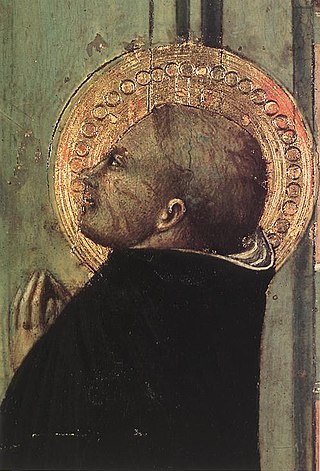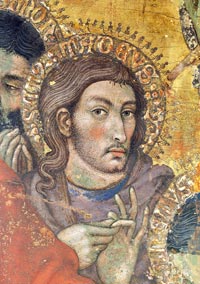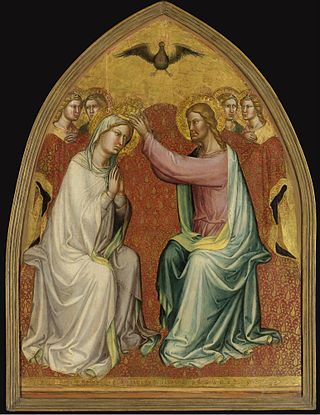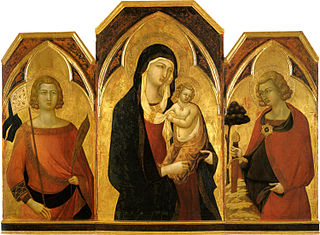Life and work
He was apparently born in Siena and may have studied with Stefano di Giovanni, known as "Il Sassetta". In 1428, he became a member of the Painter's Guild. Most of his surviving pieces date from the 1430s and 1440s. The first major work that is still extant is an altarpiece depicting the adoration of the shepherds with Saint Augustine and Saint Galgano, which dates from between 1430 and 1435 and may have been based on earlier works by Ambrogio Lorenzetti or Bartolomeo Bulgarini. Some of his works were also once attributed to Il Sassetta.
Documents from 1440 indicate that he received payment for some works done in the Città di Castello, but the nature of those works is not mentioned. That same year, he worked on frescoes at the Hospital of Santa Maria della Scala (now a museum), but these have been destroyed.
In 1444, following the death of the Franciscan priest, Bernardino (who would later become a saint), he painted a portrait of him based on his death mask, for the Basilica dell'Osservanza, which is now preserved at the Pinacoteca Nazionale. Some art historians have seen the influence of Masaccio in a set of panels from a predella, now divided between the Brooklyn Museum and the Lindenau Museum.
In 1446, he painted the Crucifixion mural at the Siena City hall (Palazzo Pubblico) and. two years later, completed another depiction of Saint Bernardino in Lucignano. He may have also participated in painting the cloister at the Monastery of the Holy Saviour in Lecceto. He and Vecchietta worked on а pair of reliquary shutters at Siena Cathedral; now in the Pinacoteca. Numerous small works from the late 1440s have been attributed to him.
In addition to his artwork, he also provided miniatures and illustrations for various books; notably the Tractatus de Principatu (1446), now in the Biblioteca Trivulziana [ it ], and an Antiphonary, which is held by the Free Library of Philadelphia.

The Sienese School of painting flourished in Siena, Italy, between the 13th and 15th centuries. Its most important artists include Duccio, whose work shows Byzantine influence, his pupil Simone Martini, the brothers Pietro and Ambrogio Lorenzetti and Domenico and Taddeo di Bartolo, Sassetta, and Matteo di Giovanni.

Jacopo della Quercia, also known as Jacopo di Pietro d'Agnolo di Guarnieri, was an Italian sculptor of the Renaissance, a contemporary of Brunelleschi, Ghiberti and Donatello. He is considered a precursor of Michelangelo.

Ambrogio Lorenzetti or Ambruogio Laurati was an Italian painter of the Sienese school. He was active from approximately 1317 to 1348. He painted The Allegory of Good and Bad Government in the Sala dei Nove in Siena's Palazzo Pubblico. His elder brother was the painter Pietro Lorenzetti.

For the village near Livorno, see Sassetta, Tuscany

Taddeo di Bartolo, also known as Taddeo Bartoli, was an Italian painter of the Sienese School during the early Renaissance. His biography appears in the Vite of Giorgio Vasari, who claims that Taddeo was the uncle of Domenico di Bartolo.
Sano di Pietro or Ansano di Pietro di Mencio (1405–1481) was an Italian painter of the Sienese school of painting. He was active for about half a century during the Quattrocento period, and his contemporaries included Giovanni di Paolo and Sassetta.

Matteo di Giovanni was an Italian Renaissance artist from the Sienese School.
The decade of the 1440s in art involved some significant events.

Astolfo Petrazzi (1583–1665) was an Italian painter of the Baroque period, active mainly in his hometown of Siena, but also Spoleto and Rome. He was a pupil of mainly Francesco Vanni, but also worked under Ventura Salimbeni and Pietro Sorri. He died in Siena.

Martino di Bartolomeo or Martino di Bartolomeo di Biago was an Italian painter and manuscript illuminator active between 1389 and 1434. He was one of his generation's principal painters of the Sienese School. From specific aspects of his early style, he is believed to have trained in the studio of Taddeo di Bartolo. As a young man Martino collaborated with Giovanni di Pietro da Napoli in Pisa. The fresco cycle in the church of San Giovanni Battista di Cascina, outside Pisa, bears Martino’s signature, and the date 1398. He returned permanently to Siena in 1405; there he painted several prominent fresco cycles in the Duomo and the Palazzo Pubblico. Further official commissions for altarpieces and for polychromy of sculptures attest to his versatility and to his prestige as one of the city’s official artists.

The Master of the Osservanza Triptych, also known as the Osservanza Master and as the Master of Osservanza, is the name given to an Italian painter of the Sienese School active about 1430 to 1450.

Bernardino Fungai was an Italian painter whose work marks the transition from late Gothic painting to the early Renaissance in the Sienese school. He maintained a fairly archaic style in his works, which are mainly of a devotional nature.

Bartolomeo Bulgarini, also known as Bulgarino or Bologhini, was an Italian painter of the Trecento period in Siena both before and after the Black Death.

Siena is a city in Tuscany, Italy. It is the capital of the province of Siena. Siena is the 12th largest city in the region by number of inhabitants, with a population of 53,062 as of 2022.

The Pinacoteca Nazionale is a national museum in Siena, Tuscany, Italy. Inaugurated in 1932, it houses especially late medieval and Renaissance paintings from Italian artists. It is housed in the Brigidi and Buonsignori palaces in the city's center: the former, built in the 14th century, it is traditionally identified as the Pannocchieschi family's residence. The Palazzo Bichi-Buonsignori, built in the 15th century, was until recently thought to have a 19th-century neo-medieval façade based on the city's Palazzo Pubblico; however, restoration in 2022 revealed that it is mostly original.
Francesco di Bartolommeo Alfei was an Italian painter of the Renaissance, active in Siena. Like other Sienese painters, and different from the contemporary Florentine style, Alfei maintained a gothic and mystical style of painting.

Andrea di Niccolò, also Andrea di Niccolò di Giacomo, (1440–1514) was an Italian painter of the Sienese School.
Meo di Pero, also called Meo di Piero was an Italian painter active in Siena in a Gothic style. He worked in the studio of Cristoforo di Bindoccio. All the latter paintings are generally co-attributed to Meo, since no independent work is known.
Guccio di Mannaia was an Italian goldsmith from Siena, Italy active from 1288 to 1322. He is best known for a 13th-century decorated gold-plated chalice which contains the first documented use of translucent enamels using the technique known as basse-taille.

The Museo d'Arte Sacra della Val d'Arbia is a small museum of religious art in Buonconvento, in the Val d'Arbia to the south of Siena, in Tuscany in central Italy. It contain a number of paintings by important artists of the Sienese School, among them Duccio di Buoninsegna, Sano di Pietro and Pietro Lorenzetti. The museum is housed in the Palazzo Ricci Socini, close to the parish church of Santi Pietro e Paolo.
















